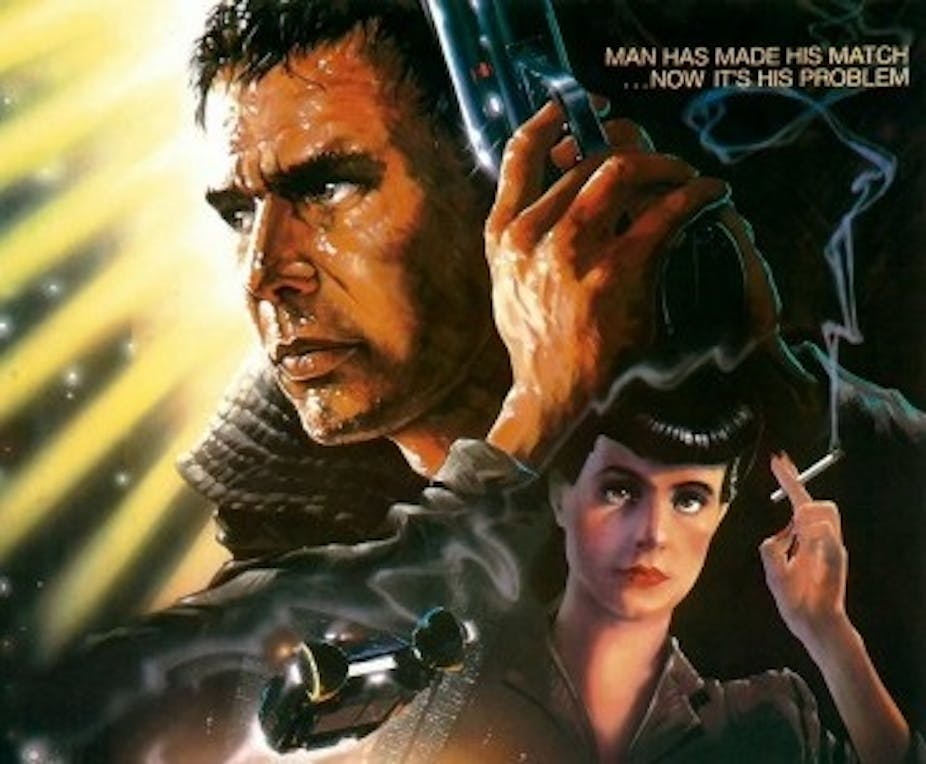This is the fifth in a weekly series called “Under the influence”, in which we ask experts to share what they believe are the most influential works of art in their field. Here, the University of Johannesburg’s James Sey introduces Ridley Scott’s cult film, “Bladerunner”, released in 1982.
OK. Confession time. I’ve seen Ridley Scott’s “Blade Runner” at least 50 times. I know the entire screenplay of the director’s cut off by heart. I have owned three different VHS versions, three different DVD versions (including a very collectable 12" laser disc) and have downloaded the ever-expanding online FAQ. Sad, isn’t it?
My only excuse is that this version of acid-head science-fiction pulp genius Philip K Dick’s novel, “Do Androids Dream of Electric Sheep?”, is a movie of almost total prescient brilliance.
Cyberpunk guru William Gibson went to see it when he was just beginning to write his seminal debut novel, “Neuromancer”. Legend has it that he walked out halfway through, saying later that the movie was too much like the inside of his head.
“Blade Runner” is one of those films that seemed predestined for underground immortality. Generally consigned to the “flawed but fairly interesting” category by most movie critics on its release, it was famously withdrawn from release to be re-cut. It was also given a laughable voice-over narrative to explain it better to the popcorn brigade.

Since then the film has, like “Casablanca”, transcended its formula trappings as a sci-fi cum hardboiled noir detective thriller to spawn a dedicated cult following and fill a special niche in pop culture. One of the touchstones for its cult value over the years has been its singularity – it has never spawned any overt remakes or sequels, despite being hugely influential. Until now, that is. The news that Scott himself is involved in bringing a sequel to the screen, scheduled for release in late 2017, is making fans edgy and ambivalent.
Why is/was it influential?
“Blade Runner’s” storyline and theme is on one level a well-worn one. It is the Frankenstein theme – science creating life, or technogenesis. But it’s the way in which the film broaches that theme that has remained prescient and influential. It was released long before the advent of the commercial internet, and long before the headline experiments in stem cell research, genetic modification and human genome sequencing.
The film posits that commercially viable superhumans – known as replicants – have been created by science, and now pose a threat to their human creators as a rogue band of them return to earth to seek answers to the mystery of their lives. Police agents, known as blade runners, hunt them down and terminate (or “retire”) them.
The genre combination of savvy sci-fi with hardboiled noir thriller was unique at the time, and has since spawned many cinema imitators – “Minority Report”, “AI”, “I, Robot” – but the film’s most marked influence has been visual. Its celebrated “retrofitted” production design – of a 21st-century Los Angeles megacity gradually imploding, overpopulated, largely Asian, and constantly raining from self-created weather conditions – has inspired numerous copycats, especially in advertising.

The term “retrofitted” was coined to describe the film’s clever design, with its postmodern flourishes and visual in-jokes. One of the best of these is a decrepit building in the city in which the final showdown between blade runner Deckard (Harrison Ford) and lead replicant Batty (Rutger Hauer) takes place.
An existing architectural landmark in Los Angeles, it’s called the Bradbury, a nod to Golden Age sci-fi author Ray Bradbury. Another building is called the Hundertwasser, a nod to the famously quirky Austrian architect.
The film’s main theme is brilliantly realised, even with, and perhaps because of, the lack of sophisticated computer-generated imagery. Drawing on its own visual template – Fritz Lang’s sci-fi cinema classic “Metropolis” (1927) – for the vision of a technology-saturated early 21st century, it achieves the same level of visual artistry about a city of the future as Stanley Kubrick’s “2001: A Space Odyssey” did about outer space.
It also gave two relatively unknown actors major cachet, which they used in different ways. Harrison Ford, who plays world-weary, compassionate, perhaps even a replicant, blade runner Deckard, went on to A-list Hollywood stardom.

Rutger Hauer, the prodigal son and leader of the rogue replicants, turned in the performance of his life as Batty (cult trainspotters can quote the entire “I’ve seen things you people wouldn’t believe … attack ships on fire off the shoulder of Orion” etc speech), and then descended into the cult movie underworld, reprising the outlaw cyborg figure in a stream of dire B-movies (the brilliant “The Hitcher” perhaps the only notable exception).
Why is it still relevant?
Perhaps the true index of the movie’s cult status is the vociferous debates about its different versions. One of the first contemporary films to have a collectable director’s cut version, which is radically different in feel to the commercial, noir voiceover release (as well as suggesting that the hero is a replicant), it also has the aforementioned laser disc version that, for initiates, contains subtle differences in soundtrack and visual editing.
Its astounding look has not dated at all, testimony to its intelligence and style. It has given the contemporary lexicon at least two new words – replicant and retrofitted – and its compelling urban future vision has been widely imitated.
In the final analysis its influence and relevance, as well as its continuing hold on me as a writer and film fan, are also tied into the age-old theme of technogenesis. In an effort to control the replicants better, the genetic engineers install implanted memories and a four-year lifespan.
The replicants constantly refer to their self-knowledge (Batty memorably says to the genetic engineer who makes eyes for the replicant series, “if only you could see what I have seen with your eyes”), and develop their own emotions as time passes. This astonishingly stylish realising of a complicated philosophical theme is the real triumph of the film.
The central concern is an ontological one: what are the psychological consequences for technologically created subjects who cannot reconcile their human-like consciousness to their status as made, not born?
Finally, the tragic fallen angel replicants of the film are denied “truly” human status by their relation to their own deaths. That is, they can have no productive conflict between life-instincts and death-instincts if they are always already aware of the hour of their deaths. It remains one of the most poignant aesthetic representations of the issue.
If ever a film was worthy of its underground reputation and cult influence, “Blade Runner” is it.

